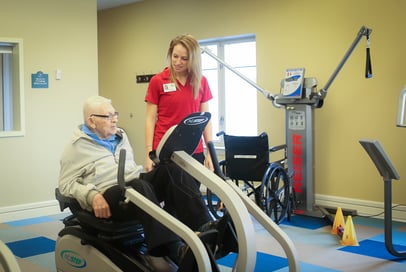.jpg?width=320&name=TRX%20Cher%20(2).jpg) There are a number of misconceptions these days about personal trainers and what it’s like to be one. Don’t all personal trainers have perfect bodies and eat nothing but fruits, vegetables, and protein shakes? Sure, you’ll have a select number of trainers who eat, sleep, and breathe fitness, but the vast majority of us are just normal people. Let’s debunk some of these common myths about personal trainers.
There are a number of misconceptions these days about personal trainers and what it’s like to be one. Don’t all personal trainers have perfect bodies and eat nothing but fruits, vegetables, and protein shakes? Sure, you’ll have a select number of trainers who eat, sleep, and breathe fitness, but the vast majority of us are just normal people. Let’s debunk some of these common myths about personal trainers.
- We eat healthy foods every day of the week. While most trainers enjoy a nutritious, well-balanced diet, most have no problem mixing in a few splurge meals throughout the week. I personally follow extremely strict nutrition Monday morning through Friday afternoon, and then reward myself with fresh pasta or pizza and breadsticks for a Friday dinner. You better believe I’m getting up early on Saturday morning for a long bout of cardio to put those extra carbs to good use!
- We work out two or three times a day. It’s true, trainers should practice what they preach; however, most of us only work out once a day, most days of the week. One big misconception is that trainers and fitness specialists spend most of their workday working out. I actually had a friend ask me, “What do you do all day at work, just work out?” I was flabbergasted with my friend’s question. Whether I’m delivering fitness and nutrition presentations, making workouts for group exercise classes and clients, or creating fun and exciting fitness challenges, most fitness professionals don’t spend all day “just working out.”
- We love all types of exercise. Variety in your workouts is essential, but any trainer would be lying if they said they love all modes of fitness. Most trainers have been working out long enough to recognize what they enjoy, so they generally stick to those methods of exercise to maintain a healthy weight. The key is understanding your client’s needs, and providing them with a variety of options that work for their likes and dislikes. For example, I have two left feet in Zumba class and feel like I might drown in a pool, but I understand that some clients thrive in a choreographed class or swimming freestyle.
- We never get hurt. It’s true that trainers should be demonstrating impeccable technique and injury prevention form while exercising. The truth is that even trainers can overdo it with too much weight or too many repetitions. Furthermore, trainers can sometimes feel like Superman or Superwoman and try things outside of traditional exercises that could potentially hurt them. I learned this the hard way recently while thinking I could ski all day for four days straight in Colorado. The second to last day of my vacation I severely tweaked my back, making the long plane ride home almost unbearable. I credit my consistent core training for my quick recovery; however, I learned my lesson that anyone can overdo it.
- We’ve never had issues with our weight or body. Believe it or not, trainers can be even more self-conscious than their clients. We have problem areas and imperfections. We look in the mirror and wish a certain part of the body was more defined or had less fat. We set such high standards for ourselves; it’s easy to be extra critical of the way we look. Most good trainers can relate to these insecurities and use these feelings to help empathize with clients. Eventually trainers and clients alike have to learn to accept imperfections and embrace the beautiful qualities of their body.
Now that you know a little more about what it’s like to be a personal trainer, you can learn more about personal training at NIFS, and even get a free 30-minute assessment.

 This is really what it’s all about, right? You want a passionate, capable, competent, self-starter running the exercise program in the community. You need someone who will
This is really what it’s all about, right? You want a passionate, capable, competent, self-starter running the exercise program in the community. You need someone who will

 Let me start by saying I’m not here to dog personal training. There is absolutely a niche for that fee-based service, and there is clearly a clientele for it. It should definitely remain an option in fitness centers.
Let me start by saying I’m not here to dog personal training. There is absolutely a niche for that fee-based service, and there is clearly a clientele for it. It should definitely remain an option in fitness centers. Have you heard this
Have you heard this  There are many reasons for seeking the help of a personal trainer. Corporate health and fitness specialists can introduce you to an exercise routine, help you break through a rut, or give you the extra boosts of knowledge, motivation, and accountability that you need to achieve the next level in your fitness. But how do you pick a trainer?
There are many reasons for seeking the help of a personal trainer. Corporate health and fitness specialists can introduce you to an exercise routine, help you break through a rut, or give you the extra boosts of knowledge, motivation, and accountability that you need to achieve the next level in your fitness. But how do you pick a trainer?